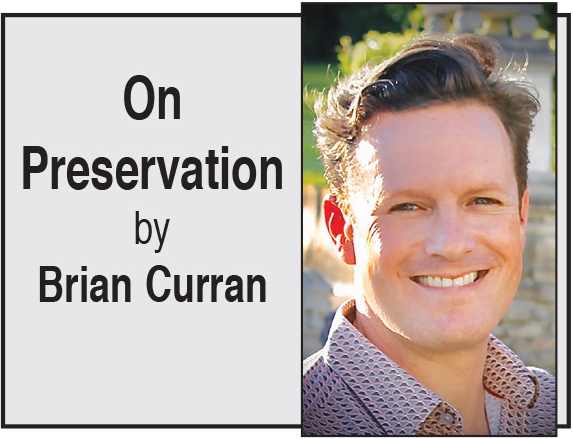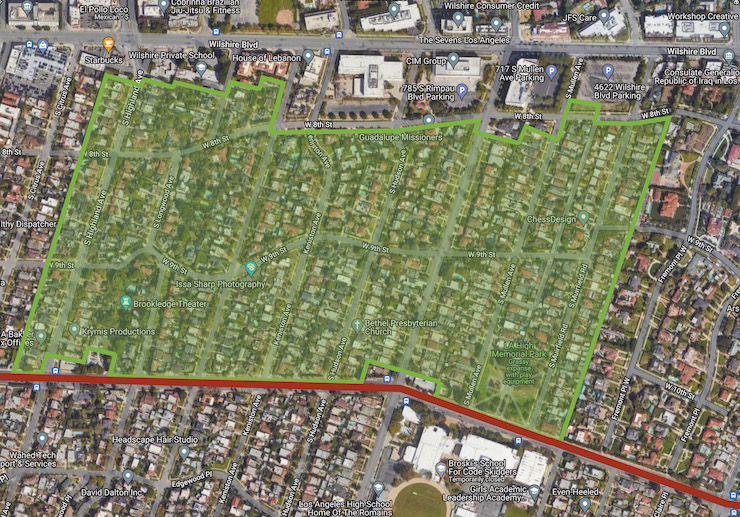Brookside and the varied, winding paths to preservation
 Last month, we began a report on the possible creation of additional historic districts in the Greater Wilshire area — [“Room to Grow?: Preserving not-yet-designated historic districts”].
Last month, we began a report on the possible creation of additional historic districts in the Greater Wilshire area — [“Room to Grow?: Preserving not-yet-designated historic districts”].
Let us begin our exploration of the undesignated historic districts of Greater Wilshire with a closer look at what SurveyLA refers to as the Wilshire Crest – Mullen Park Residential Historic District, a place we know better as Brookside. Nestled between Olympic Boulevard to the south and the Park Mile section of Wilshire Boulevard to the north, and between both sides of Highland Avenue to the west and both sides of Muirfield Road to the east, this district is significant not only for its historic architecture but its distinctive landscape feature, El Rio del Jardin de las Flores, which sets it apart from other local undesignated historic neighborhoods on our list.
Notable buildings
The neighborhood is home to a handful of important architectural sites, including the famed Chateau Le Moine (the Monk’s Castle) at 846 S. Longwood Ave. by Earl LeMoine; the Farmer’s Insurance Building, 4680 Wilshire Blvd. by Claude Beelman; 4922 W. Eighth St. by Ralph C. Flewelling; and other residences by prolific California architects John Byers and Edwin C. Thorne. The district also is home to the famous Brookledge Theater, 929 S. Longwood Ave., the precursor to the Magic Castle.
Brookside also has the remnant of one of Los Angeles’ great lost architectural ensembles, the Memorial Branch Library by John C. Austin (architect of the Griffith Observatory), with its adjoining Los Angeles High School Memorial Park to honor the high school’s students who served in World War 1. The library and park sit opposite the now lost Elizabethan palace building of Los Angeles High School.
Early history
Brookside traces its roots to the Rancho Las Cienegas and its illustrious owner, Don Francisco Jose Avila, whose youngest daughter Francisca married a German immigrant, Theodore Rimpau. The Rimpau family, besides being instrumental in the development of Anaheim and Orange County, also established the Rimpau Estate Company which — as the city of Los Angeles expanded — sold off portions of the Rancho Las Cienegas for development. In 1921, this included what became Wilshire Crest, as it was situated on the highest elevation along Wilshire Boulevard. (An entire block at this highest point on Wilshire Boulevard was sold to the Roman Catholic Archdiocese as the site for a new cathedral. See the story in Section 1, Page 17.)
Wilshire Crest joined Windsor Square and Fremont Place, and, later, Hancock Park, in developers’ rush to attract families migrating from West Adams and other rapidly commercializing neighborhoods closer to Downtown. Wilshire Crest was subdivided into lots of varied sizes, with larger more luxurious lots for two-story homes on the west, and smaller lots, generally built upon with one-story bungalows, on the east.
The brook

BROOKSIDE is nestled between Olympic and Wilshire boulevards and both sides of Highland Avenue and Muirfield Road.
But Wilshire Crest had an amenity that its neighbors could not offer, a brook, El Rio del Jardin de las Flores, itself a tributary of Ballona Creek which originates in springs in the Hollywood Hills. According to the Windsor Square – Hancock Park Historical Society, Wilshire Crest’s planners laid out Longwood Avenue so that the brook snaked from one side of the street to the other “preserving some of the natural arroyos, barrancas and hills of the original tract — still there to this day.” At the time of the 1978 creation of the Wilshire Homeowners’ Alliance, Wilshire Crest was denominated South Brookside in honor of its famous brook, soon to be shortened to Brookside, as the neighborhood is known today.
2015 Survey LA
SurveyLA evaluated the area in 2015, awarding it the rather clunky name, the Wilshire Crest – Mullen Park Residential Historic District. Surveyors found that, out of 396 properties surveyed, 326 were considered contributors to the historic district. This official survey proved in a definitive way the historic significance of the community.
While previous attempts had been made to create a Brookside Historic Preservation Overlay Zone (HPOZ) — I participated in one in 2009 — the survey plus the appearance of new McMansions, (also known as “BWB” — big white boxes) subsequently has galvanized the community.
Brooksiders were not unanimous in their desire for an HPOZ in 2009. Some argued that the process was too long and expensive to be able to quickly address the tear-down issue. Others feared that the HPOZ would “historicize” Brookside and prevent such innovative modern designs as Linda Pollari and Robert Somol’s Off Use House at 950 S. Highland Ave. and Dan Brunn Architecture’s Bridge House at 750 S. Longwood Ave. In October 2015, Councilman David Ryu of CD4 spearheaded the passing of an Interim Control Ordinance (ICO) halting demolition for two years, while — after considerable debate — a new R-1 sub-zone for Brookside was established. This new zone, R1V3-RG, dictates the size and lot coverage of new construction and requires garages to be in the rear of the property.
While this recent fine-tuning of the zoning does maintain the scale of structures within the neighborhood, it lacks the breadth of protection provided by HPOZs, as it does not prevent demolition of historic properties nor provide detailed design guidelines for new structures.
Future protection?
Nonetheless, the new zoning and the enduring strength of the Brookside Homeowners Association have reinforced the fact that Brookside is an historic neighborhood to be handled with care. Case in point, the soon-to-be-underway successful evolution of the landmark Farmer’s Insurance Building and its vacant parking lots into housing completely consistent with the restrictions of the city’s Park Mile Specific Plan.
I will always retain a soft spot for Brookside, as it was where I owned my first home and participated in community groups and advocacy, including one of the attempts to create an HPOZ.
And while I have every confidence in the residents’ ability to protect their neighborhood, I am still convinced that Brookside requires some formal recognition of its historic significance with some level of individual project review, however meager. Too much has been lost or eroded away in bad alterations that could have been prevented. Perhaps the listing of a Brookside Historic District on the National Register of Historic Places?
This designation has served well the Wilton Historic District further to the east — allowing the City of Los Angeles Office of Historic Resources to weigh in on issues and provide guidance.
Brookside’s path to preservation has not been a conventional one, but I, for one, hope to see it one day take its proper place where it belongs among HPOZs and historic districts of Greater Wilshire.
Category: Real Estate
